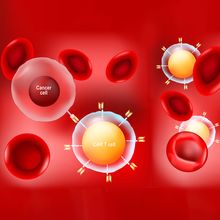Login
Subscribemedicine, immunology

Meningitis Bacteria Trigger Headaches, Then Sneak Into the Brain
Natalia Mesa, PhD | Mar 6, 2023 | 3 min read
Researchers find that bacteria stimulate a headache-causing pain pathway to suppress the immune system and infect the brain.

Opinion: New Diabetes Drug Signals Shift to Preventing Autoimmunity
Jane Buckner, MD and Carla Greenbaum, MD | Mar 1, 2023 | 4 min read
A therapy for type 1 diabetes is the first to treat patients before symptoms appear, paving the way toward preventing this and other autoimmune diseases.

Researchers Make Alternatives to Shark-Sourced Vaccine Ingredient
Natalia Mesa, PhD | Feb 22, 2023 | 3 min read
Synthetic variations of squalene, which is used to boost immune responses, could make vaccines more effective while reducing fisheries for struggling sharks.

Jumping Genes Put a Target on Cancerous Cells
Natalia Mesa, PhD | Feb 14, 2023 | 4 min read
Two studies find that tumor-specific antigens are often peptides that result from a splicing event between exons and transposable elements.

Targeting Antigen “Sanctuary” in Lymph Nodes Could Make Vaccines Better
Natalia Mesa, PhD | Feb 10, 2023 | 3 min read
Researchers find that small sacks inside lymph nodes contain low proteolytic activity and act as safe havens for antigens.

“Origami” DNA Traps Could Keep Large Viruses From Infecting Cells
Natalia Mesa, PhD | Jan 18, 2023 | 4 min read
By engineering structures out of DNA, scientists could potentially prevent larger viruses, like coronaviruses and influenza viruses, from interacting with cells.

Viral Protein Behind Chronic Inflammation in People with HIV: Study
Natalia Mesa, PhD | Dec 12, 2022 | 3 min read
The HIV protein Nef can cause long-term genetic changes that lead to hyperreactive immune cells, according to research in human cells and mice.

Blood Thinner Ineffective for COVID-19 Patients: Study
Dan Robitzski | Nov 28, 2022 | 2 min read
A clinical trial finds that the anticoagulant apixaban, which has been prescribed to help COVID-19 patients recover, is ineffective and in rare instances dangerous.

Can We Predict How Well Someone Will Respond to a Vaccine?
Natalia Mesa, PhD | Nov 14, 2022 | 7 min read
Researchers find signatures pre- and post-vaccination that correlate with a more robust immune response.

The Unscientific King: Charles III’s History Promoting Homeopathy
Sophie Fessl, PhD | Sep 29, 2022 | 6 min read
King Charles III has a long history of promoting homeopathic or alternative medical treatments not supported by scientific evidence.

Vitamin D Likely Doesn’t Prevent COVID-19, Studies Find
Dan Robitzski | Sep 9, 2022 | 2 min read
The results from two large clinical trials don't support the idea that supplements of the vitamin bolster immune defenses against SARS-CoV-2.

How COVID-19 Affects Pregnancy
Amanda Heidt | Aug 16, 2022 | 10 min read
Evidence thus far shows that pregnant people infected with SARS-CoV-2 are at higher risk for severe disease and death, as well as complications in their pregnancies.

FDA To Stretch Monkeypox Vaccine Supply via Intradermal Injection
Shafaq Zia | Aug 12, 2022 | 4 min read
The newly authorized intradermal vaccination only requires one-fifth of the usual vaccine dose. This will help stretch out the limited vaccine supply, experts say, but only if healthcare personnel receive sufficient training.

Antibiotics Tied to Lower Effectiveness of Childhood Vaccines
Natalia Mesa, PhD | Apr 28, 2022 | 2 min read
Use of the drugs in children under the age of two was associated with lower antibody levels after the jabs—perhaps, researchers suggest, due to microbiome alterations.

Skin Cells Can Transform To Help Fight Acne
Dan Robitzski | Mar 2, 2022 | 5 min read
A new study reveals that the fibroblasts in tissue surrounding acne infections play an active role in the body’s immune response—and that existing treatments help trigger them to do so.

Woman Seemingly Cured of HIV After Umbilical Cord Transplant
Natalia Mesa, PhD | Feb 16, 2022 | 3 min read
Umbilical cord blood may be a good alternative to bone marrow transplants for treating HIV in patients with HIV and cancer.

Ten Years On, CAR T Cell Recipient Is Still Cancer-Free
Jef Akst | Feb 3, 2022 | 2 min read
First, the genetically engineered cells became CD8+ killer T cells that wiped out his leukemia. Then they transformed into a stable population of CD4+ helper T cells that continue to circulate in his body.

How Mild Is Omicron Really?
Dan Robitzski | Jan 14, 2022 | 9 min read
Early reports that Omicron causes less-severe disease than Delta seem to be borne out, but it’s not yet clear to what extent that’s due to the variant itself versus the populations it’s infecting.

CAR T Cells Mend Broken Mouse Hearts
Sophie Fessl, PhD | Jan 6, 2022 | 4 min read
Specialized immune cells generated in vivo reduce cardiac scar tissue in mice, a new study shows.
